6 Plants for Colorful Fall Foliage in the Water-Wise Western Garden
http://decor-ideas.org 10/03/2015 02:13 Decor Ideas
Before you lament a fall season devoid of colorful fall foliage in the arid West and Southwest regions of the U.S., here are some favorite water-wise shrubs and trees that will add glorious color in varying shades of orange, red and burgundy to your arid autumn landscape.
Like most water-wise plants, the following do best in well-drained soil. The watering guidelines given are approximate and may need to be adjusted in response to variables such as sun exposure, soil and climate. In general, drought-tolerant plants do best when the soil is watered deeply and then allowed to dry out before the next watering. Plant in fall or wait until spring, and enjoy fall color for years to come.
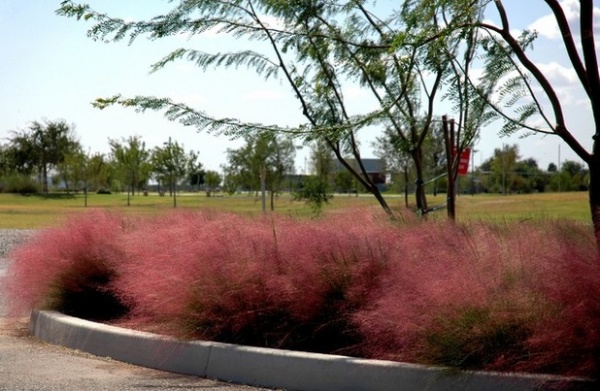
Pink Muhly Grass
(Muhlenbergia capillaris)
Native to the eastern U.S.
In spring and summer, this ornamental grass provides an attractive backdrop with its graceful green foliage. As temperatures begin to fall and days begin to shorten, burgundy-pink plumes softly wave above the green blades, and pink muhly grass takes center stage in the garden. Its color slowly fades to a lovely wheat color in winter. Plant it in groups of three, five or seven for the greatest effect.
Where it will grow: Hardy to 0 degrees Fahrenheit, or minus 18 degrees Celsius (USDA zones 7 to 9; find your zone)
Water requirement: Low to moderate; can survive on little water, but flowering is improved with regular summer irrigation. Water every 10 to 14 days in summer, every two weeks in spring through fall and monthly in winter for the best flowering.
Light requirement: Full, reflected sun to filtered shade
Mature size: 3 feet tall and wide
Planting notes: Plant in well-drained soil in full sun or filtered shade; cut back to the ground in late winter; apply a slow-release fertilizer in spring.
See how to grow pink muhly grass
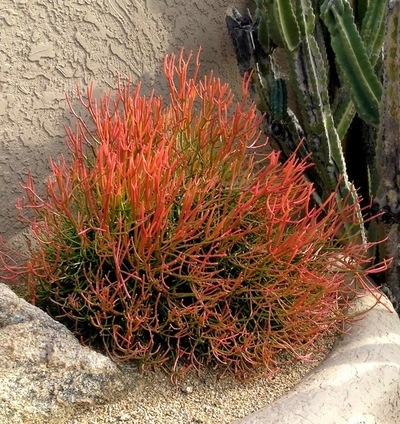
‘Sticks on Fire’ Milk Bush
(Euphorbia tirucalli ‘Sticks on Fire’)
Native to South Africa
Orange splashes of color come from an unexpected source with this drought-tolerant succulent. ‘Sticks on Fire’ differs from the green-colored parent plant in that it is smaller and new growth has a bright orange color. The color fades to yellow and then green in summer only to turn orange again when temperatures cool. In cooler climates it can be grown in a container and brought indoors when temperatures dip below freezing. Milk bush can easily be propagated from cuttings. Be sure to wear gloves when handling this plant, as its milky sap can irritate skin and eyes.
Where it will grow: Hardy to 30 degrees Fahrenheit, or minus 1 degree Celsius (zones 9 to 11)
Water requirement: Low; water every three weeks spring through fall and monthly in winter. In the low desert, water twice a month spring through fall.
Light requirement: Full sun to filtered shade (full sun is needed for it to develop the orange color)
Mature size: 4 to 8 feet tall and 3 to 5 feet wide
Planting notes: Plant in well-drained soil in full sun.
See how to grow milk bush
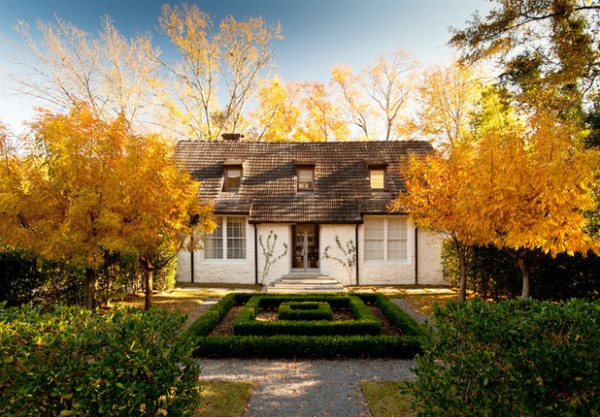
Chinese Pistache
(Pistacia chinensis)
Native to the eastern U.S.
Chinese pistache is for those who are looking for a tree that produces colorful fall foliage and will thrive in dry, arid climates. It is widely grown throughout the Northwest and the southern half of the United States, and is a go-to tree for reliable autumn color in the Southwest. In fall, bright green leaves give way to shades of yellow followed by orange and red, providing much-desired fall color for the drought-tolerant garden. Female trees produce berries that attract birds. This tree isn’t fussy about soil, as long as it’s well-drained, but it does need room to grow to its full size.
Where it will grow: Hardy to minus 10 degrees Fahrenheit, or minus 23 degrees Celsius (zones 6 to 9)
Water requirement: Low to moderate; water to 3 feet every 10 to 14 days in summer, every three weeks in spring through fall and monthly in winter
Light requirement: Full, reflected sun to filtered shade
Mature size: 30 to 60 feet tall and 30 to 40 feet wide
Planting notes: Plant in well-drained soil in full sun or filtered shade; prune in winter to shape.
See how to grow Chinese pistache
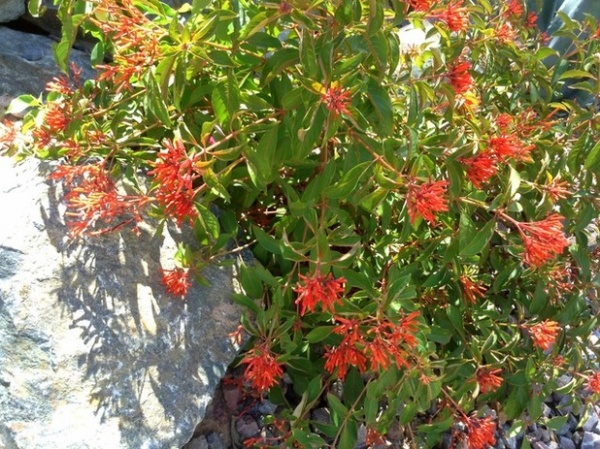
Firebush
(Hamelia patens)
Native to Florida, Mexico and Central America
The attractive orange-red flowers are the main attraction in spring and summer, and are a major hummingbird attractor, but the foliage has its turn to shine in fall when it turns a vibrant shade of red. This heat-loving shrub grows into a small tree in tropical climates, and can grow aggressively in its native Southeast, but is easily maintained as a colorful shrub in the drought-tolerant landscape. Firebush dies back to the ground when temperatures dip into the 20s but grows back in spring. In zones 7 and below, it can be grown as an annual.
Where it will grow: Hardy to 10 degrees Fahrenheit, or minus 12 degrees Celsius (zones 7 to 11)
Water requirement: Moderate; water 18 inches to 2 feet deep weekly in summer, every 10 to 14 days in spring through fall and every three weeks in winter
Light requirement: Full and reflected sun to filtered shade (full sun is best for flowering)
Mature size: 4 to 5 feet tall and wide
Planting notes: Plant in well-drained soil; prune back in spring, after the danger of frost has passed.
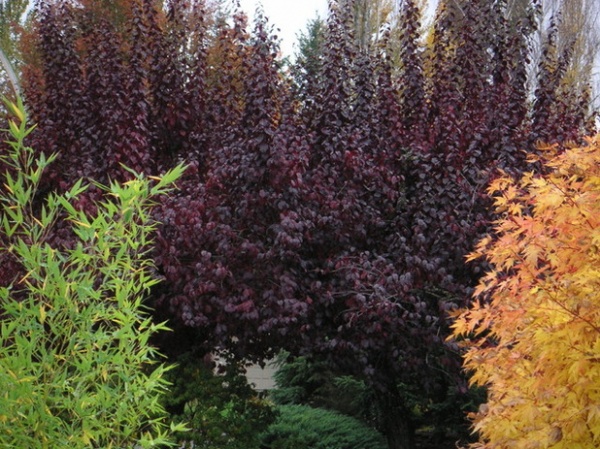
‘Krauter Vesuvius’ Cherry Plum
(Prunus cerasifera ‘Krauter Vesuvius’)
Native to Southwest Asia
This plum tree species is well-known for its burgundy-purple foliage that is present in spring through fall. While it is a plum tree, the fruit is often small or nonexistent. This purple-leafed plum tree is grown for its foliage, not its fruit. Pale pink flowers appear in spring, with the dark-colored foliage soon following. There are many varieties of cherry plum, and ‘Krauter Vesuvius’ is the most drought-tolerant, handling hot, dry summers well.
The tree here is framed by golden bamboo (Phyllostachys aurea) on the left and coral bark Japanese maple (Acer palmatum ‘Sango-kaku’) on the right.
Where it will grow: Hardy to minus 20 degrees Fahrenheit, or minus 29 degrees Celsius (zones 5 to 9)
Water requirement: Moderate; water to 2 to 3 feet every 10 to 14 days in summer, every two to three weeks in spring and fall, and monthly in winter. In the low desert, water weekly in summer and every 10 to 12 days in spring and fall.
Light requirement: Full sun to filtered shade (full sun is needed for maximum purple color)
Mature size: 15 to 20 feet tall and wide; smaller cultivars are available
Planting notes: Plant in well-drained soil; any pruning should be done in winter when the tree is dormant.
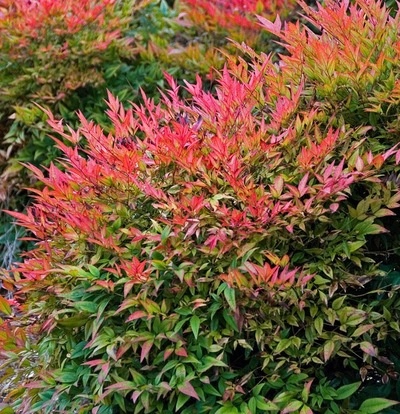
Heavenly Bamboo
(Nandina domestica)
Native to China and Japan
The finely textured leaves and upright stems of this Asian shrub are often described as bamboo-like, although it is not a true bamboo. New growth has a burgundy tint to it, fading to bright green in spring and summer. The cool temperatures of fall and winter transform the foliage into lovely shades of red. Small flowers turn into red berries in fall. Moderately drought-tolerant, heavenly bamboo does well in arid regions, where its vigorous growth is kept under control.
Caution: Heavenly bamboo is known to become invasive when planted in the eastern half of the U.S., where abundant rainfall is present, but is a popular plant in arid regions of the country. All parts of this shrub are poisonous.
Where it will grow: Hardy to minus 10 degrees Fahrenheit, or minus 23 degrees Celsius (zones 6 to 9)
Water requirement: Low to moderate; water to 18 inches to 2 feet twice a month in summer, every three weeks in spring and fall, and monthly in winter; in the low-desert water weekly in summer and twice a month in spring and fall
Light requirement: Full sun to filtered shade (does best in filtered to full shade in the low desert)
Mature size: 4 to 6 feet tall and 3 feet wide; smaller cultivars are available
Planting notes: Plant in well-drained soil; selectively prune older branches at the base in late winter or early spring.
More: See more fall gardening guides
Related Articles Recommended












